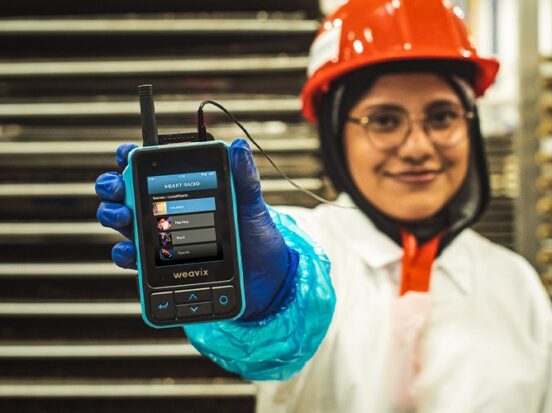Work can encourage camaraderie and create a greater sense of purpose. But your teammates on the frontline must also endure constant noise, repetition, and long hours to get the job done. Music in the workplace can ease many of these stress factors while improving productivity and employee experience during every shift.
Now you can make it easy for your team to listen to approved music with the Walt® Smart Radio System. With Walt Music By iHeartRadio, everyone on your team can enjoy music for the frontlines throughout their workday. From mood-boosting to enhancing focus, the benefits of listening to music while working are vast and well-documented.
Music in the workplace offers six major advantages to your workers on the frontline.
Key highlights:
- Music in the workplace can boost motivation and job satisfaction. This helps teams focus on their tasks and enjoy the workday.
- Teams that listen to music at work feel less stressed and anxious in fast-paced environments, and they experience a more positive atmosphere even during peak hours.
- With Walt Music By iHeartRadio, every worker equipped with a Walt Smart Radio can easily tune into a curated playlist directly on their device.
1. Higher Workplace Satisfaction
Music has the remarkable ability to elevate mood and create a sense of happiness. Incorporating music in the workplace can infuse the day with a dose of joy, making tasks feel more manageable and enjoyable.
Keep reading: Understand how music makes workers even more connected
2. Energy and Efficiency
If you ever find yourself struggling to muster the energy to tackle that daunting project, music might just be the remedy. Listening to music in the workplace can also boost energy levels and enhance efficiency.
Whether it’s the invigorating beat of an up-tempo track or the soothing melodies of a classical composition, music has the power to revitalize the spirit and propel workers through even the most demanding tasks.
3. Focus and Attention
The fast pace of the frontline can make sustained focus a constant battle. Fortunately, music can serve as a powerful ally in sharpening concentration. Music at work can provide the mental clarity needed to tackle complex projects with precision and efficiency.
4. Improved Memory
Tunes can also enhance memory function and cognitive performance. By incorporating music into the work routine, you can optimize the brain’s ability to encode and retain information, leading to improved performance and productivity.
5. Reduced Stress and Anxiety
The demands of the workplace can bring feelings of stress and anxiety. Thankfully, music can help calm frazzled nerves. By choosing one of the top iHeartRadio stations in your area, workers can create their own space among the noise on the floor for a sense of calm and well-being.
Keep reading: Discover how safety-compliant music helps you protect workers across facilities
6. Increased Motivation
When struggling to stay motivated, music can be your muse. Whether it’s the chorus of a favorite song or the mind-sharpening magic of an instrumental track, music has the power to spark and maintain inspiration.
By harnessing the motivational effects of music in the workplace, anyone can overcome obstacles and get the job done with confidence.
Let Your Frontline Enjoy the Benefits of Music at Work with Walt
Incorporating safety-compliant music into the workday isn’t just about creating a background soundtrack — it’s about harnessing the transformative power of sound to enhance work.
From boosting mood and energy to sharpening focus and reducing stress, the benefits of listening to music while working are undeniable. So why not press play and discover the future of workforce music? With the right playlist on the Walt Smart Radio System, you can turn even the most mundane tasks into inspiration and productivity.
To learn more about safety-compliant music in the workplace, how it works, and how it can keep teams safer and more connected, schedule a demo today.
Frequently Asked Questions
Does music in the workplace increase productivity?
Music and productivity in the workplace are closely linked, with research showing that the right soundtrack can improve both efficiency and mood. A study of software developers found that participants not only reported better moods with music but also completed tasks more efficiently, with performance improving by an average of 20% once music was reintroduced after a silent period.
Another experiment in PLOS ONE showed that listening to upbeat, “happy” classical music boosted divergent thinking scores from 76.1 in silence to 93.9 with music, a significant jump in creativity.
Of course, not all music is equally effective, especially when there’s too much stimulation. For example, reading or writing tasks may be disrupted by lyrical songs, particularly in the listener’s native language, while instrumental or familiar tracks often improve focus. The best approach is to match the style of music to the type of work and, whenever possible, give employees a voice in choosing what they hear.
What is the best type of music to play in work environments?
The truth is, there’s no one-size-fits-all answer. The best music depends on the type of work being done, the company culture, and personal preferences. What matters most is that it supports focus and boosts morale without becoming a distraction. We recommend letting your employees choose so long as it is aligned with your company’s brand values. Check out this article on “Should we turn off the music?” for some ‘science’ and research behind it.
Another note: Music is deeply cultural, and workplaces today are often multilingual and multicultural. That means the “best” music is not just about genre, but about inclusivity and familiarity. A balanced approach allows different teams to listen to music they relate to.. This not only boosts focus and productivity but also celebrates diversity and creates a sense of belonging.
That said, here’s a breakdown aligning the type of work with the best music types. Remember that music is very personal.
| Work Context | Best Music Types | Why It Works |
|---|---|---|
| Deep Focus / Individual Work | Instrumental, lo-fi, classical, ambient | Lyrics can distract; steady rhythms improve concentration |
| Creative Work / Brainstorming | Upbeat pop, light electronic, indie | Energizing and rhythmic, helps spark new ideas |
| Collaborative / Shared Spaces | Neutral playlists, acoustic, jazz | Keeps atmosphere positive and inclusive without overpowering conversations |
| Routine / Repetitive Tasks | Soft rock, chill hop, background beats | Makes repetitive tasks more engaging and less monotonous |
| End of Day / Wind Down | Relaxed acoustic, mellow jazz, ambient | Helps ease stress and transition smoothly out of work mode |
Can I use Walt to listen to music at work?
Yes, you can use Walt Music for Frontline to listen to music at work, and it’s one of the most popular ways employees enhance their day on the job. We have a lot of customers who opt to have this feature on. Walt provides seamless access to iHeart Radio.
Whether your employees prefer instrumental tracks for focus, upbeat playlists for energy, or culturally diverse music that reflects your workplace, iHeart Radio provides a wide variety of listening options. Since it’s designed for workplace use, you can enjoy music without interfering with communication or safety. By using Walt for music, employees can boost morale, improve concentration, and create a more positive work environment.
How does Walt Music By iHeartRadio work?
Walt Smart Radio works with iHeartRadio to make music in the workplace simple, engaging, and safe. Through this integration, employees can stream their favorite local radio stations, podcasts, and playlists directly on their Walt Smart Radios without needing personal devices.
The system is designed with built-in controls that allow administrators to decide how music is used on-site. Admins can enable or disable music at a site level, require headphones, set maximum volume limits, and even apply geofences that automatically pause music in high-attention areas. These features make it possible for workers to enjoy the benefits of music in the workplace, such as better focus, improved morale, and a more enjoyable environment, while ensuring that safety and communication remain top priorities.
What are the best practices for listening to music in the workplace?
The best practices for listening to music in the workplace are especially important in hazardous environments, where safety and awareness must come first. When managed properly, the benefits of music at work include improved morale, reduced fatigue, and better focus during long or repetitive shifts. Follow these practices:
- Keep volume at safe levels so alarms, equipment, and supervisor instructions can always be heard.
- Ensure you can still be aware of your surroundings from an auditory environmental perspective
- When first starting out testing music in the workplace, get employee feedback and call it a pilot or test first.
- Apply geofences or rules to pause music in high-risk areas, such as near heavy machinery or forklifts.
- Encourage your employees to match music to the task, choosing upbeat music for repetitive work and instrumental tracks for concentration.
- Encourage music in different languages so everyone has options
- Provide music in designated break areas for relaxation and morale boosting.
- Give employees a voice in music choices to ensure engagement and satisfaction.
By following these steps, factories can safely integrate music into daily operations and unlock the full benefits of music at work while keeping safety the top priority.
What does OSHA say about loud music in the workplace?
While OSHA does not regulate music specifically, it sets clear standards for occupational noise exposure that are directly relevant to the use of loud music in the workplace.
According to OSHA’s rule 29 CFR 1910.95, employers must implement a hearing conservation program when employees are exposed to an average of 85 dBA over an eight-hour shift. When noise exposure exceeds 90 dBA, employers are required to use administrative or engineering controls or provide personal protective equipment to protect against hearing loss.
Moreover, OSHA’s interpretation letter concerning headphone use on construction sites makes clear that while there’s no specific rule against listening to music, employers must evaluate and manage potential hazards from loud music masking important warning sounds, such as heavy machinery, alarms, or co-worker instructions. Claims that headphones are “OSHA approved” are misleading, because OSHA does not certify or endorse products.
To summarize:
- OSHA’s noise standards target overall sound exposure, not just loud music.
- Sound levels over 85 dBA demand hearing conservation efforts; beyond 90 dBA, more direct intervention is required.
- Employers must assess whether loud music interferes with safety and could result in violations under the general duty clause.
These regulations highlight why using thoughtfully designed equipment like Walt Smart Radio with in-ear audio, volume limits, and geofencing is so valuable. It allows workplaces to deliver the benefits of music at work while still prioritizing worker safety in line with OSHA expectations.


